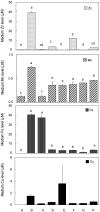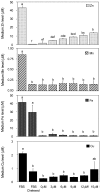Cellular Zn depletion by metal ion chelators (TPEN, DTPA and chelex resin) and its application to osteoblastic MC3T3-E1 cells
- PMID: 20535382
- PMCID: PMC2882573
- DOI: 10.4162/nrp.2007.1.1.29
Cellular Zn depletion by metal ion chelators (TPEN, DTPA and chelex resin) and its application to osteoblastic MC3T3-E1 cells
Abstract
Trace mineral studies involving metal ion chelators have been conducted in investigating the response of gene and protein expressions of certain cell lines but a few had really focused on how these metal ion chelators could affect the availability of important trace minerals such as Zn, Mn, Fe and Cu. The aim of the present study was to investigate the availability of Zn for the treatment of MC3T3-E1 osteoblast-like cells and the availability of some trace minerals in the cell culture media components after using chelexing resin in the FBS and the addition of N,N,N',N'-tetrakis-(2-pyridylmethyl)ethylenediamine (TPEN, membrane-permeable chelator) and diethylenetriaminepentaacetic acid (DTPA, membrane-impermeable chelator) in the treatment medium. Components for the preparation of cell culture medium and Zn-treated medium have been tested for Zn, Mn, Fe and Cu contents by atomic absorption spectrophotometer or inductively coupled plasma spectrophotometer. Also, the expression of bone-related genes (ALP, Runx2, PTH-R, ProCOL I, OPN and OC) was measured on the cellular Zn depletion such as chelexing or TPEN treatment. Results have shown that using the chelexing resin in FBS would significantly decrease the available Zn (p<0.05) (39.4 +/- 1.5 microM vs 0.61 +/- 10.15 microM) and Mn (p<0.05) (0.74 +/- 0.01 microM vs 0.12 +/- 0.04 microM). However, levels of Fe and Cu in FBS were not changed by chelexing FBS. The use of TPEN and DTPA as Zn-chelators did not show significant difference on the final concentration of Zn in the treatment medium (0, 3, 6, 9, 12 microM) except for in the addition of higher 15 microM ZnCl(2) which showed a significant increase of Zn level in DTPA-chelated treatment medium. Results have shown that both chelators gave the same pattern for the expression of the five bone-related genes between Zn- and Zn+, and TPEN-treated experiments, compared to chelex-treated experiment, showed lower bone-related gene expression, which may imply that TPEN would be a stronger chelator than chelex resin. This study showed that TPEN would be a stronger chelator compared to DTPA or chelex resin and TPEN and chelex resin exerted cellular zinc depletion to be enough for cell study for Zn depletion.
Keywords: DTPA; MC3T3-E1 cells; TPEN; Zn depletion; chelexing; metal ion chelators.
Figures




Similar articles
-
Apoptosis induced by chelation of intracellular zinc is associated with depletion of cellular reduced glutathione level in rat hepatocytes.Chem Biol Interact. 2000 Mar 15;125(3):151-63. doi: 10.1016/s0009-2797(99)00166-0. Chem Biol Interact. 2000. PMID: 10731516
-
Acute dietary zinc deficiency in rats exacerbates myocardial ischaemia-reperfusion injury through depletion of glutathione.Br J Nutr. 2019 May;121(9):961-973. doi: 10.1017/S0007114519000230. Epub 2019 Feb 22. Br J Nutr. 2019. PMID: 30791962
-
Zinc chelator TPEN induces pancreatic cancer cell death through causing oxidative stress and inhibiting cell autophagy.J Cell Physiol. 2019 Nov;234(11):20648-20661. doi: 10.1002/jcp.28670. Epub 2019 May 3. J Cell Physiol. 2019. PMID: 31054150
-
Development of novel oocyte activation approaches using Zn2+ chelators in pigs.Theriogenology. 2019 Feb;125:259-267. doi: 10.1016/j.theriogenology.2018.11.008. Epub 2018 Nov 20. Theriogenology. 2019. PMID: 30476759
-
Cytotoxic effects of intra and extracellular zinc chelation on human breast cancer cells.Eur J Pharmacol. 2007 Feb 14;557(1):9-19. doi: 10.1016/j.ejphar.2006.11.010. Epub 2006 Nov 10. Eur J Pharmacol. 2007. PMID: 17169355
Cited by
-
Protecting the Achilles heel: three FolE_I-type GTP-cyclohydrolases needed for full growth of metal-resistant Cupriavidus metallidurans under a variety of conditions.J Bacteriol. 2024 Feb 22;206(2):e0039523. doi: 10.1128/jb.00395-23. Epub 2024 Jan 16. J Bacteriol. 2024. PMID: 38226602 Free PMC article.
-
Zinc deficiency causes neural tube defects through attenuation of p53 ubiquitylation.Development. 2018 Dec 13;145(24):dev169797. doi: 10.1242/dev.169797. Development. 2018. PMID: 30545932 Free PMC article.
-
Discovery, validation, and prodrug design of an ACE2 activator for treating bacterial infection-induced lung inflammation.J Control Release. 2023 Dec;364:1-11. doi: 10.1016/j.jconrel.2023.10.025. Epub 2023 Oct 21. J Control Release. 2023. PMID: 37858626 Free PMC article.
-
A chemically induced attenuated strain of Candida albicans generates robust protective immune responses and prevents systemic candidiasis development.Elife. 2024 May 24;13:RP93760. doi: 10.7554/eLife.93760. Elife. 2024. PMID: 38787374 Free PMC article.
-
The Effect of Exogenous Zinc Concentration on the Responsiveness of MC3T3-E1 Pre-Osteoblasts to Surface Microtopography: Part II (Differentiation).Materials (Basel). 2014 Feb 11;7(2):1097-1112. doi: 10.3390/ma7021097. Materials (Basel). 2014. PMID: 28788502 Free PMC article.
References
-
- Aisen P, Listowsky I. Iron transport and storage proteins. Annu Rev Biochem. 1980;49:357–393. - PubMed
-
- Avery RA, Bettger WJ. Zinc deficiency alters the protein composition of the membrane skeleton but not the extratability of oligomeric form of spectrin in rat erythrocyte membrane. J Nutr. 1992;122:428–434. - PubMed
-
- Bray TM, Bettger WJ. The physiological role of zinc as an antioxidant. Free Radic Biol Med. 1990;8:281–291. - PubMed
-
- Beyersmann D, Haase H. Functions of zinc in signaling, proliferation and differentiation of mammalian cells. Biometals. 2001;14:331–341. - PubMed
LinkOut - more resources
Full Text Sources
Other Literature Sources
Research Materials

